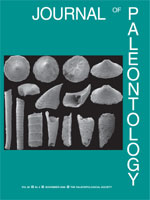Dolostones of the upper Piauí Formation, Parnaíba Basin, northern Brazil, preserve a rich and diversified invertebrate fauna of Morrowan to Desmoinesian age. Among bivalves, Heteroconchia (15 species) is the most diversified, followed by Pteriomorphia (11 species), and rare endobenthic species of the Palaeotaxodonta (three species). Eleven species of Pteriomorphia are described, including representatives of the genera Parallelodon?, Myalina?, Septimyalina, Caneyella?, Leptodesma (Leptodesma), L. (Leiopteria), Meekopinna?, Aviculopinna?, and Aviculopecten. A new combination, Etheripecten trichotomus, and the oldest member of the Anomiidae recorded, Pindorama nordestina n. gen. and sp., also are described. Details of muscle scars and hinge characters have been recovered for several taxa, thereby refining the knowledge for species diagnoses. Fossil beds in the Esperança and Mucambo dolostones reveal episodic burial of bivalves in life position. These are internally complex, multistory fossil concentrations recording background and episodic processes. Hence, those fossil concentrations show high degrees of time-averaging and poor paleoecological resolution (except for the bivalves preserved in situ).
How to translate text using browser tools
1 November 2006
PENNSYLVANIAN PTERIOMORPHIAN BIVALVES FROM THE PIAUÍ FORMATION, PARNAÍBA BASIN, BRAZIL
LUIZ E. ANELLI,
A. C. ROCHA-CAMPOS,
MARCELLO G. SIMÕES
ACCESS THE FULL ARTICLE

Journal of Paleontology
Vol. 80 • No. 6
November 2006
Vol. 80 • No. 6
November 2006




